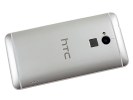Introduction
It's phablet o'clock on HTC's watch and they're shifting gear and changing direction. Done expanding the One portfolio towards the compact end of the spectrum, It builds on a proven formula emphasizing media consumption and looks, while bringing a few welcome new features to the lineup. HTC are going the other way with the aptly named One Max.
HTC One Max official images


 There's also the latest Android release powering the whole thing,
coupled with the most up-to-date edition of HTC's proprietary Sense UI. The expandable storage deals with one of the chronic liabilities of
the One, so you're no longer limited in your selection of videos and
songs to enjoy on the excellent speakers and the now even bigger screen.
There's also the latest Android release powering the whole thing,
coupled with the most up-to-date edition of HTC's proprietary Sense UI. The expandable storage deals with one of the chronic liabilities of
the One, so you're no longer limited in your selection of videos and
songs to enjoy on the excellent speakers and the now even bigger screen. Key features
- Quad-band GSM/GPRS/EDGE support; 3G with HSPA; LTE
- Quad-core 1.7 GHz Krait 300 CPU, 2 GB RAM, Adreno 320 GPU; Qualcomm Snapdragon 600 chipset
- Android OS v4.3 Jelly Bean with Sense UI 5.5
- 4 MP autofocus "UltraPixel" camera with 1/3" sensor size, 2µm pixel size; LED flash
- 1080p video recording @ 30fps with HDR mode, continuous autofocus and stereo sound
- HTC Zoe
- 2.1 MP front-facing camera, 1080p video recording
- Wi-Fi a/b/g/n, Wi-Fi Direct and DLNA; Wireless TV-out (Miracast)
- GPS with A-GPS, GLONASS
- 16GB/32GB of built-in storage, expandable via a microSD slot
- MHL-enabled microUSB port
- Bluetooth v4.0
- NFC
- Standard 3.5 mm audio jack
- Accelerometer and proximity sensor
- Active noise cancellation with dedicated mic
- Sleek aluminum body
- Front-mounted stereo speakers with BoomSound tech
- Class-leading audio output
Main disadvantages
- 4MP UltraPixel camera has less than stellar performance in good light
- Non user-replaceable battery
- Poor video and audio codec support out of box
- Fingerprint scanner let down by software support
- Snapdragon 600 chipset is no longer the snappiest around




The HTC One Max at ours
So what we need to find out now is whether the Sense UI 5.5 is as good as HTC touts it to be, and whether the fingerprint scanner can be a key selling point. We already saw an excellent hardware implementation of the feature by Apple in the iPhone 5s, but the software failed to make proper use of it. We now set out to find what HTC did differently and how well it works.
No comments:
Post a Comment